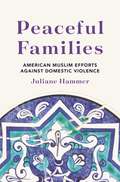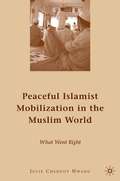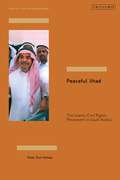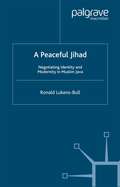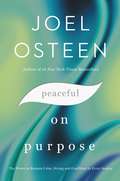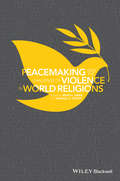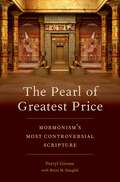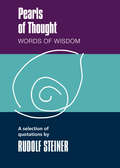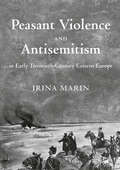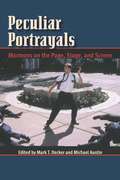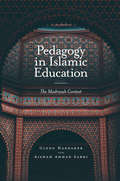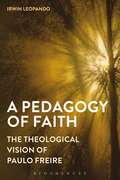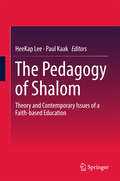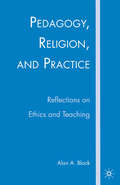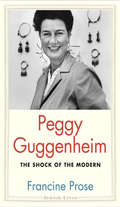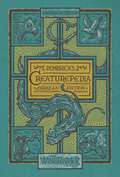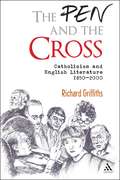- Table View
- List View
Peaceful Families: American Muslim Efforts against Domestic Violence
by Professor Juliane HammerAn in-depth look at how Muslim American organizations address domestic violence within their communitiesIn Peaceful Families, Juliane Hammer chronicles and examines the efforts, stories, arguments, and strategies of individuals and organizations doing Muslim anti–domestic violence work in the United States. Looking at connections among ethical practices, gender norms, and religious interpretation, Hammer demonstrates how Muslim advocates mobilize a rich religious tradition in community efforts against domestic violence, and identify religion and culture as resources or roadblocks to prevent harm and to restore family peace.Drawing on her interviews with Muslim advocates, service providers, and religious leaders, Hammer paints a vivid picture of the challenges such advocacy work encounters. The insecurities of American Muslim communities facing intolerance and Islamophobia lead to additional challenges in acknowledging and confronting problems of spousal abuse, and Hammer reveals how Muslim anti–domestic violence workers combine the methods of the mainstream secular anti–domestic violence movement with Muslim perspectives and interpretations. Identifying a range of Muslim anti–domestic violence approaches, Hammer argues that at certain times and in certain situations it may be imperative to combat domestic abuse by endorsing notions of “protective patriarchy”—even though service providers may hold feminist views critical of patriarchal assumptions. Hammer links Muslim advocacy efforts to the larger domestic violence crisis in the United States, and shows how, through extensive family and community networks, advocates participate in and further debates about family, gender, and marriage in global Muslim communities.Highlighting the place of Islam as an American religion, Peaceful Families delves into the efforts made by Muslim Americans against domestic violence and the ways this refashions the society at large.
Peaceful Families: American Muslim Efforts against Domestic Violence
by Professor Juliane HammerAn in-depth look at how Muslim American organizations address domestic violence within their communitiesIn Peaceful Families, Juliane Hammer chronicles and examines the efforts, stories, arguments, and strategies of individuals and organizations doing Muslim anti–domestic violence work in the United States. Looking at connections among ethical practices, gender norms, and religious interpretation, Hammer demonstrates how Muslim advocates mobilize a rich religious tradition in community efforts against domestic violence, and identify religion and culture as resources or roadblocks to prevent harm and to restore family peace.Drawing on her interviews with Muslim advocates, service providers, and religious leaders, Hammer paints a vivid picture of the challenges such advocacy work encounters. The insecurities of American Muslim communities facing intolerance and Islamophobia lead to additional challenges in acknowledging and confronting problems of spousal abuse, and Hammer reveals how Muslim anti–domestic violence workers combine the methods of the mainstream secular anti–domestic violence movement with Muslim perspectives and interpretations. Identifying a range of Muslim anti–domestic violence approaches, Hammer argues that at certain times and in certain situations it may be imperative to combat domestic abuse by endorsing notions of “protective patriarchy”—even though service providers may hold feminist views critical of patriarchal assumptions. Hammer links Muslim advocacy efforts to the larger domestic violence crisis in the United States, and shows how, through extensive family and community networks, advocates participate in and further debates about family, gender, and marriage in global Muslim communities.Highlighting the place of Islam as an American religion, Peaceful Families delves into the efforts made by Muslim Americans against domestic violence and the ways this refashions the society at large.
Peaceful Islamist Mobilization in the Muslim World: What Went Right
by Julie Chernov HwangIn Peaceful Islamist Mobilization in the Muslim World: What Went Right , Julie Chernov Hwang presents a compelling and innovative new theory and framework for examining the variation in Islamist mobilization strategies in Muslim Asia and the Middle East.
Peaceful Jihad: The Islamic Civil Rights Movement in Saudi Arabia (Critical Studies on Islamism Series)
by Peter Enz-HarlassHuman rights abuses and violations in Saudi Arabia attract international condemnation. But within the country, an Islamic civil rights movement, 'HASM', has called for change. While its members have received international human rights awards, the Saudi authorities have persecuted and imprisoned them.This book is the first to study human rights in the kingdom from the perspective of these prominent Saudi civil rights activists, uncovering the actual ideas that motivate their activism. Based on analysis of the group's texts, the book highlights that HASM neither supports an overthrow of the government, of which they are accused, nor are they “liberal” advocates of universal human rights. Their complex thought is a contribution to contemporary Islamic discourse because they make a case for 'peaceful civil jihad' through the protection of citizens' basic rights, but within a rigid, Salafist interpretation of social affairs that imposes heavy limits on politics, human rights and democracy. Furthermore, HASM's texts use war rhetoric and anti-Semitic language, with different arguments and words for domestic or international audiences. The most comprehensive text on this Islamic civil rights movement, the book employs detailed discourse analysis and includes sources from HASM texts in both Arabic and English.
Peaceful Jihad: The Islamic Civil Rights Movement in Saudi Arabia (Critical Studies on Islamism Series)
by Peter Enz-HarlassHuman rights abuses and violations in Saudi Arabia attract international condemnation. But within the country, an Islamic civil rights movement, 'HASM', has called for change. While its members have received international human rights awards, the Saudi authorities have persecuted and imprisoned them.This book is the first to study human rights in the kingdom from the perspective of these prominent Saudi civil rights activists, uncovering the actual ideas that motivate their activism. Based on analysis of the group's texts, the book highlights that HASM neither supports an overthrow of the government, of which they are accused, nor are they “liberal” advocates of universal human rights. Their complex thought is a contribution to contemporary Islamic discourse because they make a case for 'peaceful civil jihad' through the protection of citizens' basic rights, but within a rigid, Salafist interpretation of social affairs that imposes heavy limits on politics, human rights and democracy. Furthermore, HASM's texts use war rhetoric and anti-Semitic language, with different arguments and words for domestic or international audiences. The most comprehensive text on this Islamic civil rights movement, the book employs detailed discourse analysis and includes sources from HASM texts in both Arabic and English.
A Peaceful Jihad: Negotiating Identity and Modernity in Muslim Java (Contemporary Anthropology of Religion)
by R. Lukens-BullBased on extensive ethnographic research, this book examines how the Islamic community in Java, Indonesia, is actively negotiating both modernity and tradition in the contexts of nation-building, globalisation, and a supposed clash of civilizations. The pesantren community, so-called because it is centered around an educational institution called the pesantren, uses education as a central arena for dealing with globalization and the construction and maintenance of an Indonesian Islamic identity. However, the community's efforts to wrestle with these issues extend beyond education into the public sphere in general and specifically in the area of leadership and politics. The case material is used to understand Muslim strategies and responses to civilizational contact and conflict. Scholars, educated readers, and advanced undergraduates interested in Islam, religious education, the construction of religious identity in the context of national politics and globalization will find this work useful.
Peaceful on Purpose: The Power To Remain Calm, Strong, And Confident In Every Season
by Joel OsteenLive from a place of abundant peace in the midst of life's everyday worries and stress with number-one New York Times best-selling author and Lakewood Church pastor Joel Osteen. The opposite of peace is worry and stress. Both are thieves that rob you of your sleep, joy, creativity, and good decisions. If you allow them into your mind, they can even can even keep you from your destiny. But if you learn how to change your automatic responses to these struggles and give your problems to God, he can go to work in your life. If you're tired of living in tension and anxiety, then it's time to change. In Peaceful on Purpose, you will discover that you weren't designed to carry the heavy load yourself: Step back to let God step in. Find peace so that you can stop worrying about your health, job, finances, or relationships. Life may be chaotic all around you, but you can live grounded in a calm spirit by drawing on scriptural examples and Joel's insightful personal experiences to find fulfillment. Learn how to give it to God so that he can exceed your expectations.
Peacemaking and the Challenge of Violence in World Religions (Coursesmart Ser.)
by Irfan A. Omar Michael K. DuffeyWritten by top practitioner-scholars who bring a critical yet empathetic eye to the topic, this textbook provides a comprehensive look at peace and violence in seven world religions. Offers a clear and systematic narrative with coverage of Buddhism, Christianity, Confucianism, Hinduism, Islam, Judaism, and Native American religions Introduces a different religion and its sacred texts in each chapter; discusses ideas of peace, war, nonviolence, and permissible violence; recounts historical responses to violence; and highlights individuals within the tradition working toward peace and justice Examines concepts within their religious context for a better understanding of the values, motivations, and ethics involved Includes student-friendly pedagogical features, such as enriching end-of-chapter critiques by practitioners of other traditions, definitions of key terms, discussion questions, and further reading sections
Peacemaking and the Challenge of Violence in World Religions
by Irfan A. Omar Michael K. DuffeyWritten by top practitioner-scholars who bring a critical yet empathetic eye to the topic, this textbook provides a comprehensive look at peace and violence in seven world religions. Offers a clear and systematic narrative with coverage of Buddhism, Christianity, Confucianism, Hinduism, Islam, Judaism, and Native American religions Introduces a different religion and its sacred texts in each chapter; discusses ideas of peace, war, nonviolence, and permissible violence; recounts historical responses to violence; and highlights individuals within the tradition working toward peace and justice Examines concepts within their religious context for a better understanding of the values, motivations, and ethics involved Includes student-friendly pedagogical features, such as enriching end-of-chapter critiques by practitioners of other traditions, definitions of key terms, discussion questions, and further reading sections
The Pearl of Greatest Price: Mormonism's Most Controversial Scripture
by Terryl Givens Brian HauglidThe Pearl of Greatest Price narrates the history of Mormonism's fourth volume of scripture, canonized in 1880. The authors track its predecessors, describe its several components, and assess their theological significance within the Church of Jesus Christ of Latter-day Saints. Four principal sections are discussed, along with attendant controversies associated with each. The Book of Moses purports to be a Mosaic narrative missing from the biblical version of Genesis. Too little treated in the scholarship on Mormonism, these chapters, produced only months after the Book of Mormon was published, actually contain the theological nucleus of Latter-day Saint doctrines as well as a virtual template for the Restoration Joseph Smith was to effect. In The Pearl of Greatest Price, the author covers three principal parts that are the focus of many of the controversies engulfing Mormonism today. These parts are The Book of Abraham, The Book of Moses, and The Joseph Smith History. Most controversial of all is the Book of Abraham, a production that arose out of a group of papyri Smith acquired, along with four mummies, in 1835. Most of the papyri disappeared in the great Chicago Fire, but surviving fragments have been identified as Egyptian funerary documents. This has created one of the most serious challenges to Smith's prophetic claims the LDS church has faced. LDS scholars, however, have developed several frameworks for vindicating the inspiration of the resulting narrative and Smith's calling as a prophet. The author attempts to make sense of Smith's several, at times divergent, accounts of his First Vision, one of which is canonized as scripture. He also assesses the creedal nature of Smith's "Articles of Faith," in the context of his professed anti-creedalism. In sum, this study chronicles the volume's historical legacy and theological indispensability to the Latter-day Saint tradition, as well as the reasons for its resilience and future prospects in the face of daunting challenges.
The Pearl of Greatest Price: Mormonism's Most Controversial Scripture
by Terryl Givens Brian HauglidThe Pearl of Greatest Price narrates the history of Mormonism's fourth volume of scripture, canonized in 1880. The authors track its predecessors, describe its several components, and assess their theological significance within the Church of Jesus Christ of Latter-day Saints. Four principal sections are discussed, along with attendant controversies associated with each. The Book of Moses purports to be a Mosaic narrative missing from the biblical version of Genesis. Too little treated in the scholarship on Mormonism, these chapters, produced only months after the Book of Mormon was published, actually contain the theological nucleus of Latter-day Saint doctrines as well as a virtual template for the Restoration Joseph Smith was to effect. In The Pearl of Greatest Price, the author covers three principal parts that are the focus of many of the controversies engulfing Mormonism today. These parts are The Book of Abraham, The Book of Moses, and The Joseph Smith History. Most controversial of all is the Book of Abraham, a production that arose out of a group of papyri Smith acquired, along with four mummies, in 1835. Most of the papyri disappeared in the great Chicago Fire, but surviving fragments have been identified as Egyptian funerary documents. This has created one of the most serious challenges to Smith's prophetic claims the LDS church has faced. LDS scholars, however, have developed several frameworks for vindicating the inspiration of the resulting narrative and Smith's calling as a prophet. The author attempts to make sense of Smith's several, at times divergent, accounts of his First Vision, one of which is canonized as scripture. He also assesses the creedal nature of Smith's "Articles of Faith," in the context of his professed anti-creedalism. In sum, this study chronicles the volume's historical legacy and theological indispensability to the Latter-day Saint tradition, as well as the reasons for its resilience and future prospects in the face of daunting challenges.
Pearls of Thought: Words of Wisdom. A Selection of Quotations by Rudolf Steiner
by Rudolf Steiner‘Truth is simple only for those who first wrestle their way through multiplicity. It is like a thread of many pearls.’ – Rudolf SteinerLike pearls in the oyster, pearls of thought are easily overlooked. Lying hidden in texts, they keep their light under a bushel, serving the greater framework and context. But if we draw them out they begin to shine, revealing their translucent facets and intrinsic harmony.In this meditative treasure, the editor has harvested and threaded together such pearls from Rudolf Steiner’s books, creating new textures and striking panoramas. Dynamic constellations of thought arise, allowing us unusual and surprising access to Steiner’s spiritual and philosophical thinking. In contrast to the prevailing view that meaning arises only in context, these self-sufficient verbal universes show us that the opposite can also be true. The pearls of thought in this compact pocket book acquire enhanced meaning in isolation, mysteriously becoming independent of the thoughts and phrases that precede or follow them. This collection of quotations, free of jargon or technical terminology, is accessible to all readers interested in developing a meaningful understanding of the human being’s place in the world and cosmos.
Peasant Violence and Antisemitism in Early Twentieth-Century Eastern Europe
by Irina MarinThis book is a transnational study of rural and anti-Semitic violence around the triple frontier between Austria-Hungary, Romania and Tsarist Russia at the beginning of the twentieth century. It focuses on the devastating Romanian peasant uprising in 1907 and traces the reverberations of the crisis across the triple frontier, analysing the fears, spectres and knee-jerk reactions it triggered in the borderlands of Austria-Hungary and Tsarist Russia. The uprising came close on the heels of the 1905-1907 social turmoil in Tsarist Russia, and brought into play the major issues that characterized social and political life in the region at the time: rural poverty, the Jewish Question, state modernization, and social upheavals. The book comparatively explores the causes and mechanisms of violence propagation, the function of rumour in the spread of the uprising, land reforms and their legal underpinnings, the policing capabilities of the borderlands around the triple frontier, as well as newspaper coverage and diplomatic reactions.
Peasant Violence and Antisemitism in Early Twentieth-Century Eastern Europe
by Irina MarinThis book is a transnational study of rural and anti-Semitic violence around the triple frontier between Austria-Hungary, Romania and Tsarist Russia at the beginning of the twentieth century. It focuses on the devastating Romanian peasant uprising in 1907 and traces the reverberations of the crisis across the triple frontier, analysing the fears, spectres and knee-jerk reactions it triggered in the borderlands of Austria-Hungary and Tsarist Russia. The uprising came close on the heels of the 1905-1907 social turmoil in Tsarist Russia, and brought into play the major issues that characterized social and political life in the region at the time: rural poverty, the Jewish Question, state modernization, and social upheavals. The book comparatively explores the causes and mechanisms of violence propagation, the function of rumour in the spread of the uprising, land reforms and their legal underpinnings, the policing capabilities of the borderlands around the triple frontier, as well as newspaper coverage and diplomatic reactions.
Peculiar Portrayals: Mormons on the Page, Stage and Screen
by Mark T. Decker Michael AustinIn a time when Mormons appear to have larger roles in everything from political conflict to television shows and when Mormon-related topics seem to show up more frequently in the news, eight scholars take a close look at Mormonism in popular media: film, television, theater, and books. Some contributors examine specific works, including the Tony-winning play Angels in America, the hit TV series Big Love, and the bestselling books Under the Banner of Heaven: A Story of Violent Faith and The Miracle Life of Edgar Mint. Others consider the phenomena of Mormon cinema and Mormon fiction; the use of the Mormon missionary as a stock character in films; and the noticeably prominent presence of Mormons in reality television shows.
Pedagogy in Islamic Education: The Madrasah Context
by Glenn Hardaker Aishah Ahmad SabkiIn Islamic education, the development of teaching and learning for the physical and spiritual training of humanity places equal importance on revealed and acquired knowledge. This book provides a greater understanding of Islamic pedagogy from a spiritual perspective, which requires empathy with the Islamic premise of the inseparable nature of knowledge and the sacred. The book is intended to provide a particular insight into the relationship between Islamic pedagogy and embodied learning and associated common features that are seen in Madrasahs, and related educational institutions. The first part of the book traces key moments in madrasah history and their formation; diversity of Islamic institutions, and the notion of the scholastic community. It identifies the rise of the Islamic education institutions and the diversity within their formation. Despite the partial disappearance of the spiritual in many Islamic education institutions, the authors argue that the spiritual construct is still deeply implicated in the reification of Islamic pedagogy and in the process of embodiment. The second part of the book draws on unravelling knowledge and the sacred that considers the philosophy of Islam and knowledge, spiritual understanding of Islamic education, and knowledge and the sacred as an educational compass. Finally, the book explores the implications of Islamic pedagogy and embodied learning, the universal nature of Islamic pedagogy, and reflections for the future. By bringing to bear a variety of Islamic and educational studies research, relative to Islamic pedagogy, this book opens up new avenues for research into Islamic education. The book will be of particular interest to scholars investigating Islamic education, Islamic pedagogy, and embodied learning.
Pedagogy in Islamic Education: The Madrasah Context
by Glenn Hardaker Aishah Ahmad SabkiIn Islamic education, the development of teaching and learning for the physical and spiritual training of humanity places equal importance on revealed and acquired knowledge. This book provides a greater understanding of Islamic pedagogy from a spiritual perspective, which requires empathy with the Islamic premise of the inseparable nature of knowledge and the sacred. The book is intended to provide a particular insight into the relationship between Islamic pedagogy and embodied learning and associated common features that are seen in Madrasahs, and related educational institutions. The first part of the book traces key moments in madrasah history and their formation; diversity of Islamic institutions, and the notion of the scholastic community. It identifies the rise of the Islamic education institutions and the diversity within their formation. Despite the partial disappearance of the spiritual in many Islamic education institutions, the authors argue that the spiritual construct is still deeply implicated in the reification of Islamic pedagogy and in the process of embodiment. The second part of the book draws on unravelling knowledge and the sacred that considers the philosophy of Islam and knowledge, spiritual understanding of Islamic education, and knowledge and the sacred as an educational compass. Finally, the book explores the implications of Islamic pedagogy and embodied learning, the universal nature of Islamic pedagogy, and reflections for the future. By bringing to bear a variety of Islamic and educational studies research, relative to Islamic pedagogy, this book opens up new avenues for research into Islamic education. The book will be of particular interest to scholars investigating Islamic education, Islamic pedagogy, and embodied learning.
A Pedagogy of Faith: The Theological Vision of Paulo Freire
by Irwin LeopandoThis is the first book-length study in English to investigate Freire's landmark educational theory and practice through the lens of his lifelong Catholicism. A Pedagogy of Faith explores this often-overlooked dimension of one of the most globally prominent and influential educational thinkers of the past fifty years. Leopando illustrates how vibrant currents within twentieth-century Catholic theology shaped central areas of Freire's thought and activism, especially his view of education as a process of human formation in light of the divinely-endowed “vocation” of persons to shape culture, society, and history. With the contemporary resurgence of authoritarian political and cultural forces throughout much of the world, Freire's theologically-grounded affirmation of radical democracy, social justice, historical possibility, and the absolute dignity of the human person remains as vital and relevant as ever.
A Pedagogy of Faith: The Theological Vision of Paulo Freire
by Irwin LeopandoThis is the first book-length study in English to investigate Freire's landmark educational theory and practice through the lens of his lifelong Catholicism. A Pedagogy of Faith explores this often-overlooked dimension of one of the most globally prominent and influential educational thinkers of the past fifty years. Leopando illustrates how vibrant currents within twentieth-century Catholic theology shaped central areas of Freire's thought and activism, especially his view of education as a process of human formation in light of the divinely-endowed “vocation” of persons to shape culture, society, and history. With the contemporary resurgence of authoritarian political and cultural forces throughout much of the world, Freire's theologically-grounded affirmation of radical democracy, social justice, historical possibility, and the absolute dignity of the human person remains as vital and relevant as ever.
The Pedagogy of Shalom: Theory and Contemporary Issues of a Faith-based Education
by HeeKap Lee Paul KaakBased on the teachings of Jesus and a biblical foundation, this book presents a new framework for education and teaching, referred to as the shalom education model, that addresses four essential questions in education (why teach, what to teach, how to teach and who are teachers?). After explaining the theoretical background of shalom, the book investigates a range of contemporary educational issues including gender identity, bullying, disability, linguistic and cultural diversity, and social justice, and presents practical guidelines that can be applied to classroom teaching. The book also emphasizes the role of teachers as missional leaders who help students unlock their full potential.
Pedagogy, Religion, and Practice: Reflections on Ethics and Teaching
by A. BlockThis new work from Alan Block explores the contemporary discourses of education, scholarship and learning. The book offers a strong argument for the centrality of ethics in curriculum, scholarship and the classroom, and presents a powerful argument against the present emphasis on standards and quantitative accountability.
Peggy Guggenheim: The Shock of the Modern (Jewish Lives)
by Francine ProseOne of twentieth-century America’s most influential patrons of the arts, Peggy Guggenheim (1898–1979) brought to wide public attention the work of such modern masters as Jackson Pollock and Man Ray. In her time, there was no stronger advocate for the groundbreaking and the avant-garde. Her midtown gallery was the acknowledged center of the postwar New York art scene, and her museum on the Grand Canal in Venice remains one of the world’s great collections of modern art. Yet as renowned as she was for the art and artists she so tirelessly championed, Guggenheim was equally famous for her unconventional personal life, and for her ironic, playful desire to shock. Acclaimed best-selling author Francine Prose offers a singular reading of Guggenheim’s life that will enthrall enthusiasts of twentieth-century art, as well as anyone interested in American and European culture and the interrelationships between them. The lively and insightful narrative follows Guggenheim through virtually every aspect of her extraordinary life, from her unique collecting habits and paradigm-changing discoveries, to her celebrity friendships, failed marriages, and scandalous affairs, and Prose delivers a colorful portrait of a defiantly uncompromising woman who maintained a powerful upper hand in a male-dominated world. Prose also explores the ways in which Guggenheim’s image was filtered through the lens of insidious antisemitism.
Pembrick's Creaturepedia
by Andrew PetersonThis detailed companion is essential to all who travel to the lands of Skree, and a must-have for all Wingfeather Saga fans. Now with all-new illustrations!Sketcher, adventurer, disguiser, and sneaker Ollister B. Pembrick roamed all of Skree with a sketchbook and pen, searching behind every tree stump and under every stone, in every river and on every hill, to discover and document the endless living wonders of the Maker's world. He risked life and limb--quite literally--to compile sketches and details of the creatures of Skree, usually from the cover of a hollow log, a hedge, or a pile of leaves.Refer to this carefully documented Creaturepedia before traversing through the Stony Mountains or harvesting fartichokes within a fortnight after a sandstorm. The drawings and field notes about squeeblins, toothy cows, oiples, and more will surely save any explorer's life and will definitely keep them--and their appendages--from being gobbled. Tread carefully, young adventurer. The creatures within are not to be trifled with.
The Pen and the Cross: Catholicism and English Literature 1850 - 2000
by Richard GriffithsThis incisive and perceptive new book concerns 'Catholic Literature' in Britain since 1850. To many people, Roman Catholicism is culturally foreign and 'other'. And yet some of the most outstanding writers of recent times have been Catholics - often converts, such as Evelyn Waugh, Graham Greene, Muriel Spark and David Jones. In every case these authors' Catholicism was integral to their creative genius and they represent an important strand in any account of English literature. Professor Griffiths' account is set against a wide and varied canvas. It gives a full account of the growth of Catholicism as a cultural, social and political force in Great Britain since Newman. Griffiths is concerned also to relate his story to movements on the continent and examines on his way the impact of French Catholic writers such as Huysmans, Peguy and Mauriac on their British counterparts and the influence of British Catholic writers such as Newman, Faber and Chesterton on Europe.
The Pen and the Cross: Catholicism and English Literature 1850 - 2000
by Richard GriffithsThis incisive and perceptive new book concerns 'Catholic Literature' in Britain since 1850. To many people, Roman Catholicism is culturally foreign and 'other'. And yet some of the most outstanding writers of recent times have been Catholics - often converts, such as Evelyn Waugh, Graham Greene, Muriel Spark and David Jones. In every case these authors' Catholicism was integral to their creative genius and they represent an important strand in any account of English literature. Professor Griffiths' account is set against a wide and varied canvas. It gives a full account of the growth of Catholicism as a cultural, social and political force in Great Britain since Newman. Griffiths is concerned also to relate his story to movements on the continent and examines on his way the impact of French Catholic writers such as Huysmans, Peguy and Mauriac on their British counterparts and the influence of British Catholic writers such as Newman, Faber and Chesterton on Europe.
